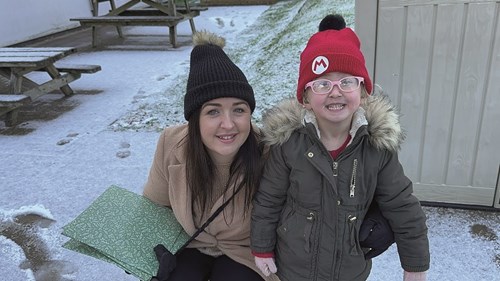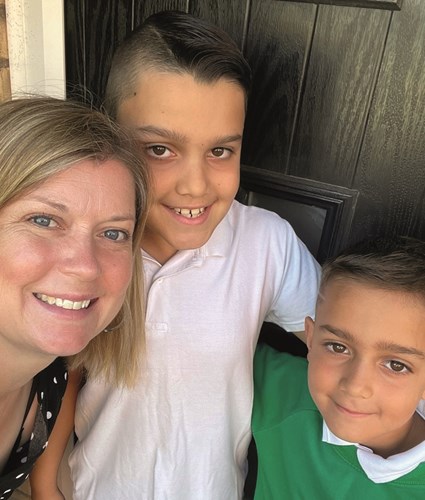Getting smart with technology
Over just a couple of decades, smart technology has rapidly developed and grown in popularity. Did you know most of these smart devices are able to support deaf children and young people with a range of tasks?
Spring 2023 Families magazine
Smart hearing devices
Hearing technology is becoming increasingly smart, with most new hearing aids, cochlear implants and bone conduction hearing devices having Bluetooth integration. This means deaf children and young people can connect them wirelessly to compatible smartphones, tablets and televisions, allowing them to hear the audio directly through their hearing devices.
Many hearing aids also have their own apps that you can connect to. These apps can help you to do things like stream phone calls, audiobooks and music, as well as check on the status of a hearing aid battery or even locate your lost hearing aids on a map. Allowing children access to the app is a great way to teach them independence in controlling and caring for their own hearing technology.

Rachel, mum of Aurora (5) who has a severe hearing loss, says:
“Aurora’s only five and she loves connecting the iPad to her Marvel hearing aids, which are Bluetooth enabled. We also use smart plugs for the TV, so if we need to get her attention when she’s watching, we can turn it off with our phone or Amazon Echo. This is great if she’s in her bedroom and wouldn’t hear us calling her to say that dinner is ready. Once she’s old enough we’ll connect the smart doorbell and post box to alert her phone or smartwatch when there’s somebody at the door.”
Smart doorbells
Smart doorbells are very popular. They’re helpful for deaf people, as they can be alerted to visitors at the door by receiving a notification on their phone, tablet or smart screen, such as the Amazon Echo Show, so they don’t have to hear the doorbell or use a flashing one. It’s also possible to see who’s at the door via the app before answering (or ignoring it!). Options we’ve tested, and found to be useful, include Ring and Blink. When considering smart technology, check if the product requires an ongoing subscription to work beyond the initial free trial, as the costs can add up.

Pip, one of our Advice and Guidance Officers, who is deaf, says:
“The Ring doorbell means I get alerts directly to my phone or smartwatch when someone is at the door and I can see who it is. This means I don’t need to rely on anyone to tell me when someone is at the door, and I can choose if I want to answer the door or not!”
Smart light bulbs
Manually switching a light bulb on and off is an effective way of getting a deaf person’s attention, but nowadays smart light bulbs can support deaf people in various ways. Smart light bulbs usually come with an app so you can program the bulbs to help with a variety of different tasks, as listed below.
- Waking up in the mornings. A smart bulb can be set to gradually brighten in the morning to encourage a deaf child or young person to wake up, without the need for a vibrating alarm clock.
- Sending children to sleep. Smart bulbs can slowly dim in the evenings, simulating a sunset, to help soothe young children to sleep.
- Using a countdown timer. Bakers can programme their smart bulbs to flash or change colour when a timer reaches zero to avoid burning treats! You could also use this to time any tasks without needing to hear an alarm.
- Alerting users to visitors. Compatible smart doorbells can connect with smart bulbs to flash or change colour, informing deaf people that someone’s at the door.
- Improving deaf awareness. Many deaf people rely on good lighting to lip-read or see signing clearly. When required, individual bulbs can be brightened through the app.
Increasing independence
We suggested a Phillips Hue motion sensor and light bulb to a deaf student who’d just moved into university accommodation. It senses movement which triggers the bulb to flash or change colour. The aim was to make sure that she wasn’t isolated and was included in the halls. It’s also useful for providing notifications when others are moving around, giving her the same experience as other residents hearing the front door open or people moving around in the hallway.
An alerting system
The Bellman & Symfon mobile phone transceiver notifies users when someone is at the door, the phone is ringing or an alarm is going off via the Bellman Visit app. You can receive notifications through your smartphone, tablet or smartwatch using Bluetooth and the app. However, you have to buy and use the Bellman & Symfon transmitters, such as a push button for the door, telephone transmitter or smoke alarm, to complete the alerting system.
Looking to the future
Oticon’s latest hearing aids and the app they use can communicate with internet-connected devices, such as smart kettles, washing machines and other appliances compatible with digital automation software IFTTT. These smart devices can be programmed to send a customised message from the app to the hearing aid. The options are endless, such as announcing Google Calendar appointments, Twitter alerts and Amazon Alexa notifications. It can be linked to smoke alarms and safety devices too, but a reliable backup is essential in case an internet connection fails.
If you’d like further information about the smart technology featured in this article and want to find out how you can include it in your home, contact us at [email protected] or visit our technology pages.
